Solar collectors for home heating - maximum savings
The man has always tried to use renewable energy sources to the maximum. Dams are built on rivers, wind energy is used, and in sunny regions, sunlight can be a good source of energy. Many are attracted by the fact that such energy is practically free - you only have to spend money on the installation of appropriate equipment and periodic maintenance.
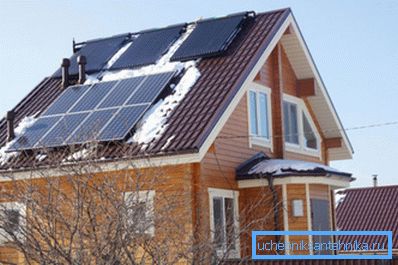
Types of solar collectors
It is reliably known that, on average, the Earth receives as much solar energy per day as all of humanity spends at best a year. Unfortunately, most of this energy is wasted. Using collectors allows you to redirect at least some of the absolutely free energy to your needs.
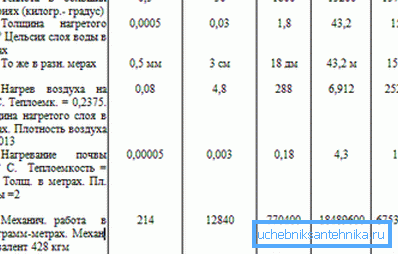
Such devices can be used, for example, for simple heating of water in the pool outside, but the heating of the house with solar collectors is becoming more and more real.
Note! The collectors are not yet in a condition to provide 100% of the house's need for heat, especially if the house is in harsh climatic conditions. Therefore, they are most often used in conjunction with more familiar heating systems.
Before you think about the collector heating system is not superfluous to get acquainted with their main types.
Allocate:
- heat pipe vacuum collectors - are considered the most perfect representatives of this class of devices. The design uses hollow sealed tubes filled with boiling liquid. When heated by sunlight, the liquid boils, evaporates and is transferred to the upper part of the tube, where it gives off heat to the coolant. In this case, the gas again goes into the state of liquid and flows down, the cycle repeats;

Note! A vacuum manifold for heat pipes costs a lot, but it's worth it. In addition to high efficiency, it also differs in damage resistance, the fact is that the tubes work independently of each other and if one of them depressurizes, the rest will still work.

- flat collector - the asborber (absorbing element) in this case looks like a plate, respectively, the power of the device depends on the size of the plate. The light-absorbing element transmits the accumulated energy to the coolant. The most effective mode of operation is considered to be the one in which the coolant should be heated to a temperature of 20-40? С more than the outside temperature.
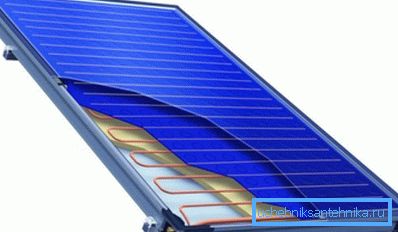
Heating on solar collectors will be more efficient in the case of using vacuum models. The fact is that the design of the tubes allows you to direct the sun's rays at an angle of 90? to the inner tube, even in the morning and evening hours. Flat collectors at this time work at times less efficiently.
The only disadvantage of vacuum devices can be considered the cost. In this case, the one-time cost of installing the heating system will be higher, on the other hand, the repair of flat collectors will be much more expensive, because you have to change the entire plate, and not a separate tube.
We should also mention the devices in which air is used as a coolant. Air solar collector for heating large areas will not work, because the air has poor thermal conductivity compared to water.
The maximum that such collectors can do is to create comfort in a small room, for example, a small workshop. In this case, the fans serve heated air into the room and there is no need to spend money on the installation of a traditional heating system.

Using a solar collector for home heating
Despite differences in design, all collectors are used for the same purpose. The principle of operation for heating systems that use solar energy is also not very different - solar energy is transferred to the coolant (most often water is used) and the heated liquid is fed further into the heating circuit.
The principle of operation of the heating system using solar collectors
Heating by solar collectors can be, both with natural, and with compulsory circulation. In the first case, the coolant moves due to the temperature difference in the supply and discharge pipelines, in the second - the circulation pump solves all issues with the movement of water around the circuit.
Note! The natural circulation system is completely independent of power supply. This can be a decisive factor for country houses in inaccessible areas.

For systems with natural circulation are characterized by such features:
- the accumulation tank is installed necessarily above the level of the collector itself;
- the upper output of the heat exchanger is the connection point of the supply pipe, the lower is the return;
- in addition to weak circulation, it can be noted that in this case there is a high risk of air traffic jams.
If there is no problem with power, then a solar collector can be used for heating with your own hands in a system with forced circulation. The operation of such a system is different in that when it reaches a certain coolant temperature, it simply turns off.
To do this, in places where the supply pipe and the return pipe are connected to the heat exchanger, sensors are installed to monitor the water temperature. Regardless of whether vacuum solar collectors are used for heating or conventional flat models, such a system is unable to heat a dwelling, therefore it is recommended to use it as an addition to, for example, gas or electric heating.
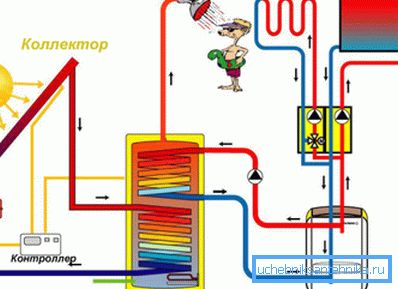
Homemade collector
Strictly speaking, even a black-painted barrel with water can be considered the simplest collector, because it converts solar energy into heat and transfers it to the coolant. It is clear that in this case the efficiency will be minimal and such a solution is suitable only for a shower at the dacha.
However, it’s easy for anyone to make a collector that can be used to heat a dwelling and supply hot water. Special skills are not required, except that the skill of working with the welding machine.
Solar collector do-it-yourself heating will consist of such elements as:
- insulated box, it will accommodate a radiator;
- aquacamera - need to create pressure in the system;
- water tank - drive;
- pipes.
The system is assembled in the following sequence:
- first the box is made, ordinary planks are suitable for it, and the bottom can be strengthened with several bars. The slots are insulated in any way possible. At the bottom of the box there should be a black metal sheet, a radiator (also painted black) is put on it, it is all covered with a transparent piece of glass and placed on the roof;
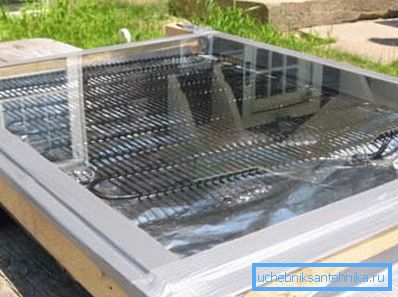
- in the attic is a cumulative tank and aqua-chamber, which is located about 1 meter above the tank;
- then the system is connected by pipes.
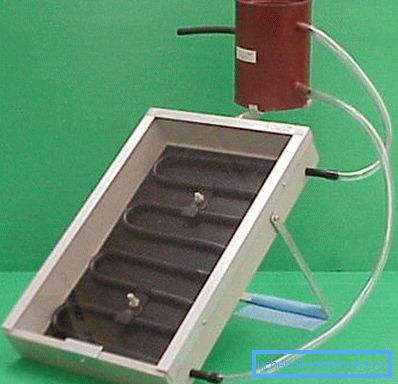
During operation, the heated water in the radiator rises up and enters the tank through the pipes, displacing cold water. Cold water on the contrary - falls into the radiator.
Note! Aquakamera performs another function - it does not allow mixing with warm and cold water.
Such a solar collector in winter can hardly be used for heating. It is rather a good way to significantly reduce the cost of paying for hot water, if desired, it can be used to slightly relieve the main heating system.
Summarizing
Solar collectors - a person's attempt to use a renewable source of energy in everyday life. Such solutions are not yet capable of providing 100%, for example, heating of housing, but can be used to reduce heating costs by about 40-60%. Considering that thermal energy is absolutely free, it is not surprising that solar collectors are popular (see also the article “Repair of ventilation: some features and recommendations of masters).
The video shows the work of a homemade collector.